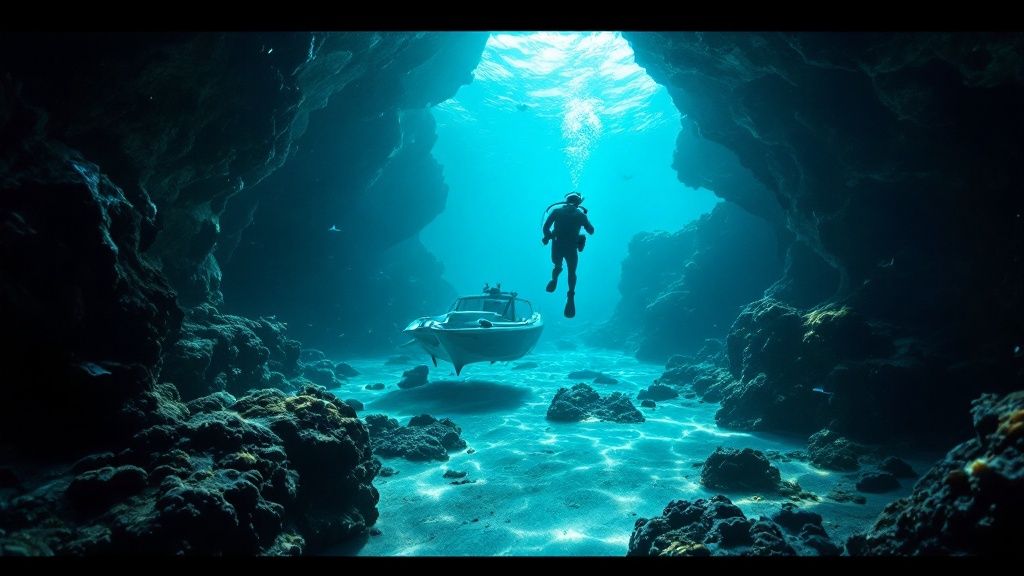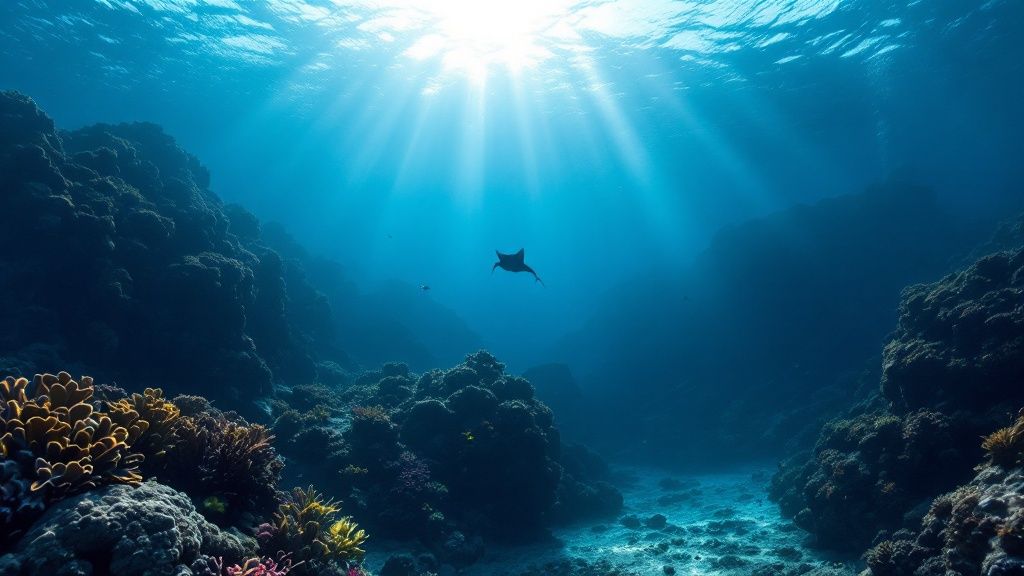The Evolution of Kona's Legendary Manta Ray Encounters

The Kona manta ray dive is a carefully orchestrated experience. It's evolved significantly from its surprising origins in 1991. Divers near the Sheraton hotel in Kailua-Kona observed a fascinating phenomenon: artificial lights attracted plankton, which then drew in magnificent manta rays.
This accidental discovery sparked immediate interest in observing these gentle giants at night. The site quickly gained popularity with both locals and tourists, eager to witness this unique feeding behavior.
However, the Sheraton hotel eventually closed. The mantas' gathering spot shifted north, nearer to the airport. This marked a turning point in the Kona manta ray encounter.
The mantas' relocation led to the development of now world-renowned dive sites: Garden Eel Cove (nicknamed "Manta Heaven") and Manta Ray Village. This shift also changed how we interact with these creatures, shaping the experience we know today. The Kona manta ray dive has become a globally renowned experience since 1991. It began at the Sheraton hotel in Kailua-Kona, where locals and visitors observed the majestic creatures feeding at night.
The mantas' subsequent move north of Kona, near the airport, led to the creation of dive sites at Garden Eel Cove and Manta Heaven. The unique feeding behavior of the manta rays, drawn in by artificial lights, attracts many tourists and researchers every year, contributing significantly to local tourism and marine biology studies. Learn more about Kona manta ray history.
The Rise of Responsible Tourism
As the Kona manta ray dive's popularity grew, local dive operators recognized the need for sustainable practices. This involved balancing the increasing tourism demand with protecting these gentle giants and their habitat.
Decades of experience have led to refined approaches that emphasize respectful interaction. Discover the magic of these nighttime encounters. Manta Ray Snorkel Kona.
A Legacy in the Making
The modern Kona manta ray dive isn't just about observing these creatures. It's about active participation in their conservation. Today's tours prioritize minimizing disturbance and maximizing educational opportunities.
This focus on sustainability ensures that future generations can also witness the magic of Kona's manta rays. From an accidental discovery to a global phenomenon, the Kona manta ray dive continues to evolve, showcasing the power of responsible tourism.
Prime Kona Manta Ray Dive Sites Worth Exploring

Not all Kona manta ray dive sites are the same. Each location offers a unique experience shaped by water depth, currents, and the underwater landscape. Understanding these differences is essential for choosing the right spot for your dive experience.
Manta Village: The Original Kona Manta Ray Hotspot
Just off the coast of the Sheraton Keauhou Bay Resort & Spa in Keauhou, Manta Village is a significant location in Kona's manta ray dive history. It's here that the mesmerizing spectacle of manta rays feeding beneath artificial lights was first discovered. Manta Village has an incredibly high sighting success rate, often exceeding 90%. This makes it ideal for first-time manta ray divers and anyone looking for a near-guaranteed encounter.
Manta Heaven (Garden Eel Cove): A Sanctuary for Mantas and Divers
North of Kona, near the airport, lies Manta Heaven, also known as Garden Eel Cove. While its sighting rate might be slightly lower than Manta Village (around 90%), it often offers encounters with multiple mantas. This concentration of majestic creatures makes it a truly unforgettable experience, particularly for seasoned divers.
To help you make an informed decision, we've put together a comparison table of these two prime dive sites:
Kona Manta Ray Dive Sites Comparison
A comprehensive comparison of the most popular manta ray dive sites around Kona, with details on accessibility, success rates, and special features
| Dive Site | Location | Access Method | Average Depth | Success Rate | Best For |
|---|---|---|---|---|---|
| Manta Village | Keauhou Bay | Boat | 30-40 ft | 90%+ | Beginners, guaranteed sightings |
| Manta Heaven | Garden Eel Cove (North of Kona) | Boat | 30-40 ft | ~90% | Experienced divers, multiple manta encounters |
This table highlights the key differences and similarities between the two sites, helping you choose the best fit for your diving experience. Manta Village offers a higher chance of seeing mantas, ideal for beginners, while Manta Heaven attracts larger groups of mantas, perfect for a more immersive experience.
Choosing the Right Kona Manta Ray Dive Site for You
The best dive site for you depends on your experience, comfort level in the water, and your expectations. Beginners might prefer the calmer waters and consistent sightings of Manta Village. More experienced divers looking for the thrill of swimming alongside larger groups of mantas might find Manta Heaven more rewarding. Researching each site will help you make a memorable choice.
Beyond the Popular Spots: Exploring Other Kona Dive Locations
While Manta Village and Manta Heaven are the most well-known, other Kona locations offer unique dive experiences. The Kohala Coast near Kawaihae Harbor, for instance, is less crowded. While sightings are less frequent here, it's an appealing option for experienced divers seeking a more secluded adventure.
Respectful Interaction: A Key Element of the Kona Manta Ray Dive
Regardless of your chosen dive site, responsible interaction with manta rays is paramount. Maintain a safe distance and avoid touching the mantas to protect their sensitive mucous layer, vital for their immune system. By prioritizing respectful diving practices, we can all contribute to the preservation of these gentle giants and the Kona manta ray experience for generations to come.
Timing Your Kona Manta Ray Dive Adventure
Unlike many marine wildlife viewing opportunities, the Kona manta ray dive isn't limited to a specific season. You can experience these gentle giants year-round. This remarkable consistency is thanks to the unique combination of factors in Kona's waters. These conditions create an ideal viewing environment across all twelve months.
Understanding Year-Round Manta Ray Presence
Manta ray sightings in Kona are remarkably consistent year-round, with no major seasonal changes. This stability is a key characteristic of the Kona manta ray population, leading to frequent encounters. The absence of seasonality allows tours and research to operate continuously, making Kona a prime location for both. The lack of a peak season differentiates manta rays from other marine species like humpback whales, which migrate seasonally. This predictability makes Kona a favorite among divers and enthusiasts seeking reliable manta ray encounters. Explore this topic further.
Additionally, the resident manta rays have a readily available food source: plankton. The plentiful plankton, attracted to the surface by artificial lights, provides a constant feast, keeping the mantas around regardless of the season.
Subtle Influences on Your Kona Manta Ray Dive
While sightings remain consistent, slight changes in ocean conditions can affect your dive experience. Water clarity, for instance, can vary throughout the year. Summer months (June through August) usually offer the clearest visibility. However, experienced operators understand how to navigate these subtle shifts to optimize viewing opportunities, even outside of peak summer months.
Lunar Cycles and Plankton Blooms: A Delicate Balance
Another factor is the relationship between lunar cycles and plankton blooms. The moon's brightness can occasionally reduce the effectiveness of artificial lights used to attract plankton. This can slightly impact the number of mantas at the surface. However, this does not mean sightings are eliminated, and experienced guides adapt their approach to ensure a memorable dive.
Maximizing Your Chances for Multiple Manta Encounters
While spotting a single manta ray is amazing, watching multiple mantas perform their graceful feeding dance is a truly special experience. Factors that can increase your chances of witnessing this spectacle include choosing the best dive site, understanding lunar influences, and selecting a reputable tour operator. Considering these factors can turn your Kona manta ray dive into an unforgettable underwater adventure.
Preparing For A 360° Kona Manta Ray Experience

Getting ready for a Kona manta ray dive is more than just throwing a swimsuit in your bag. It's about preparing yourself for a truly unforgettable and respectful encounter with these majestic creatures. This includes everything from picking the right tour operator to packing smart and getting yourself mentally prepared for a night dive.
Selecting The Right Kona Manta Ray Dive Operator
Choosing the right operator can make or break your manta ray experience. Look for businesses dedicated to sustainable tourism and manta ray conservation. For example, operators following guidelines set by organizations like Project AWARE show a genuine commitment to responsible ecotourism. This commitment helps protect the manta rays and ensures this incredible experience remains available for future generations. Kona Honu Divers, known for its excellent reviews and focus on conservation, is a great example of a reputable operator.
Gearing Up For A Night Dive
Packing the right gear will make your dive more comfortable and enjoyable. While Kona's waters are typically warm, night dives can get a bit chilly. A wetsuit is highly recommended, even if you’re a seasoned diver. Also, think about bringing a light sweater or jacket for the boat ride back to shore.
To help you prepare, here’s a handy checklist:
Before we dive into the details, let’s review a quick checklist to ensure you’re well-prepared for this unique adventure.
| Preparation Item | Night Dive | Snorkel Tour | Importance Level | Notes |
|---|---|---|---|---|
| Wetsuit | Recommended | Optional | High | Evenings can get cool |
| Towel and Change of Clothes | Essential | Essential | High | For warming up after |
| Seasickness Medication | Recommended | Recommended | Medium | If prone to seasickness |
| Personal Snorkel Gear | Optional | Optional | Low | Most operators provide gear |
| Underwater Camera | Recommended | Recommended | Medium | Capture the memories |
| Reef-Safe Sunscreen | Essential | Essential | High | Protect yourself and the environment |
This checklist summarizes the essential items and preparations you’ll need for a successful and enjoyable manta ray experience. Remember to check with your chosen tour operator for specific requirements.
Mental Preparation For The Dive
Mental preparation is just as important as the physical kind. Night diving can feel very different from daytime dives. If you're new to night diving or feeling a little apprehensive, chat with your dive guides. They are experienced professionals who are there to support you. Visualizing the dive and focusing on slow, deep breaths can also help ease any pre-dive jitters.
Respectful Manta Ray Interaction: The Unspoken Rules
Understanding manta ray etiquette is vital for protecting these amazing animals and their habitat. Never touch the mantas. Their skin has a delicate mucous layer that’s essential for their immune system. Keep a respectful distance and allow the mantas to approach you. This ensures a more natural and undisturbed encounter for everyone.
Addressing Common Concerns
- Night Diving Nerves: Talk to your dive guides about any worries you might have. They're there to offer reassurance and guidance. Many operators even allow viewing from the boat if you decide not to dive.
- Water Temperature: Even though Kona's waters are warm, a wetsuit adds an extra layer of comfort and protects you from the cooler evening temperatures.
- Underwater Communication: Familiarize yourself with basic hand signals. This will help you communicate with your guides and fellow divers.
By following these preparation tips, you'll be completely ready for a truly unforgettable Kona manta ray dive. This careful planning will allow you to fully embrace the magic of the moment, creating memories that will stay with you for a lifetime.
Understanding the Gentle Giants of Kona Waters
The Kona manta ray dive offers an incredible chance to witness these majestic creatures firsthand. But to truly appreciate this experience, you need to go beyond simply observing their graceful movements. Understanding their biology, behavior, and the conservation efforts that protect them enhances the encounter significantly. This means learning about their feeding habits, unique identification, and the important role responsible tourism plays in their protection.
The Magic of Filter Feeding and Artificial Lights
Manta rays are filter feeders. This means their diet consists of tiny plankton and krill. They feed by swimming with their mouths open, filtering the water through specialized gill plates. What makes the Kona manta ray dive particularly special is the fascinating interaction between these feeding habits and artificial lights. The lights attract plankton, creating a concentrated food source. This draws the mantas closer to the surface, giving divers and snorkelers amazing viewing opportunities.
Identifying Individual Mantas: Underwater Fingerprints
Each manta ray has a unique pattern of spots on its ventral (under) side. These patterns act like underwater fingerprints, allowing researchers to identify and track individual animals. Manta ray population identification in Kona is well-documented thanks to these distinctive ventral spot patterns. Over 330 individual mantas have been identified in the area using this method. Citizen science, with contributions from professional divers, researchers, and enthusiasts, has greatly expanded our knowledge of these animals.
The comprehensive database maintained by mantarays.info contains almost 6,000 reported encounters and over 28,500 manta sightings spanning 14 years. This extensive dataset is incredibly valuable for research on both Mobula alfredi and Mobula birostris worldwide. Find more detailed statistics here.
Conservation Challenges and the Role of Responsible Tourism
Manta rays are protected in Hawaiian waters, but they still face several threats. Bycatch in fishing nets, pollution, and habitat disruption remain ongoing challenges. Responsible tourism, however, is vital for their protection. Divers and snorkelers can contribute to ongoing research by submitting photos of manta ray ventral patterns to databases like Manta Matcher.
Reputable tour operators also play a key role. They adhere to strict guidelines designed to minimize disturbance and support conservation. These guidelines include maintaining safe distances, never touching the mantas, and educating visitors about responsible manta ray interaction.
The Future of Kona Manta Rays
The future of these gentle giants depends heavily on continued research and responsible interactions. By choosing eco-conscious tour operators, visitors actively contribute to the long-term well-being of Kona's manta rays. This helps ensure that these breathtaking encounters remain possible for generations to come. Supporting research and conservation efforts is crucial to safeguarding these magnificent creatures and ensuring the sustainability of the Kona manta ray dive experience.
Mastering Underwater Photography on Kona Manta Ray Dives

Want to transform your Kona manta ray dive into incredible photos? It takes more than just pointing and shooting. Successfully capturing these gentle giants in their natural nighttime habitat requires specialized underwater photography techniques. These methods have been honed by professionals who understand the unique challenges and opportunities these dives present.
Camera Settings for Kona Manta Ray Dives
Night dives offer different photographic obstacles than daytime dives. Low visibility and the reliance on artificial light sources necessitate some specific adjustments to your camera settings.
Start with a wide aperture (a low f-stop number like f/2.8). This maximizes the amount of light entering your lens. You’ll also need a high ISO setting, but be careful: pushing it too high can introduce unwanted noise into your images. Finally, a fast shutter speed will help freeze the mantas' movement, ensuring crisp, clear photos.
Positioning and Etiquette for Underwater Photography
Respectful interaction with the marine environment is paramount, especially when taking photographs. Position yourself thoughtfully to avoid disturbing the mantas or other divers.
Maintain a safe distance and avoid sudden movements that could frighten the animals. Also, be mindful of where your light beam is pointing. Make sure it doesn’t interfere with the mantas’ natural feeding behaviors or shine directly into the eyes of other divers.
Lighting Techniques for Dramatic Manta Ray Imagery
Lighting is key to capturing stunning manta ray images. The goal is to balance artificial light with the ambient environment without impacting the mantas’ behavior.
One popular and effective method is to use red filters on your dive lights. Red light minimizes light pollution, reduces backscatter in your photos, and helps reveal the mantas’ true colors.
Overcoming Common Underwater Photography Challenges
Underwater photography, particularly at night, comes with inherent difficulties. Backscatter from your flash or dive lights can obscure your subject. To minimize this, position your light source slightly off-axis from your lens.
Focusing can also be challenging in low visibility. Using manual focus or your camera's spot focus mode can significantly improve the sharpness of your images.
Equipment Recommendations for Every Budget
You don't need the most expensive equipment to capture memorable photos on a Kona manta ray dive. Even smartphone users can achieve excellent results with dedicated underwater housings.
If you're using a dedicated camera, a wide-angle lens is recommended for capturing the mantas’ impressive wingspan. External strobes or powerful dive lights are also essential for providing adequate illumination.
Remember, capturing these magical moments isn't solely about the gear. It’s about understanding the environment and respecting these incredible creatures. Ready to see for yourself? Dive into the experience with Kona Honu Divers.
